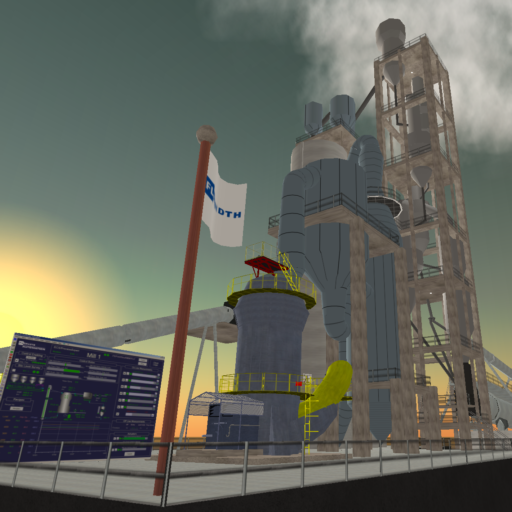Today and tomorrow I will be attending the Government 2.0 Camp. If possible, I am going to try to live blog as many sessions as I can so check back or grab a feed if you are interested in following along!
How Attending an APWA Workshop Saved Our City $1M
As management teams work on their budgets over the next few weeks, some might look at trimming expenses by cutting back on staff training. But my experience has been that a little bit of education can go a long way. Come, travel down memory lane with me, and I will show you how one workshop ended up saving our city $1,000,000 . . .
Many years ago, our city, like most, had meter readers who would travel from home to home or business to business reading the water meters. The meter reads were entered into a book; then office staff would transcribe these reads from the book into the computer. From there, water bills would be generated and sent out to users.
Eventually, the water industry began to offer products designed to automate this meter reading process. Through a long and involved journey, our city arrived, poised to implement a major change in our system involving water meter replacements and installation of an automatic meter reading system. The company offering our city the package quoted a price tag close to $2,000,000. Unfortunately, I was concerned that our city would not be able to afford this, and we would have to cut back and eliminate the portion of the package involving a fixed network system and instead choose a drive-by read system that the company quoted at $1,500,000.
During the time period in which our city was considering this company’s proposal, I attended a workshop hosted by the American Public Works Association (APWA) to learn about their accreditation program. One of the side benefits of these workshops is the chance to meet and talk with others involved in public works. So at the morning break, I had the chance to meet and visit with the person sitting next to me, Kevin Weaver, from Oakwood, Ohio. Oakwood was a city similar in size to LaSalle, and Kevin was their city engineer. We discussed the projects going on in our communities, and Kevin told me how his city was going through a water meter replacement project involving the installation of a fixed network. I told him how I wanted to implement something similar in our city, but told him I didn’t think we could afford the $2,000,000 cost. Well, imagine my surprise when Kevin told me his community was only paying about $900,000.
Kevin went on to explain how he had approached the bidding and implementation of his project. But with two cities of almost exactly the same size and number of meters, I still could not understand why our quoted price was so much more. Fortunately Kevin followed up after the workshop by sending me the bidding information so that I could try to figure out where the cost difference was.
At that point I shared this information with our council, and they approved allowing the project to be split into three contracts: one for supplying meters, one for supplying the fixed network components, and one for installation. Then, after getting cost proposals for each, we arrived at a project expense very close to that of Oakwood’s, about $1,000,000.
My cost to attend the workshop and conference that immediately followed was about $2,000. So for $2,000, not only was I able to gain experience and training, but because of meeting Kevin, I was able to find a way to implement the project we wanted at half the cost, saving $1,000,000.
Reaction Grid: Building Community, Nurturing Business, and Throwing Tomatoes
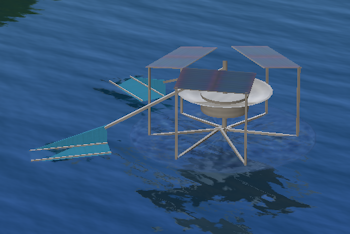 Back in 2006, I decided to join and explore the Second Life community in order to find out how it could help me as an engineer. I was also interested in finding out how it could help promote our community. As I became more involved, I realized there was even more potential to virtual worlds than I had imagined. Over the years, I eventually saw more ideas and uses emerge.
Back in 2006, I decided to join and explore the Second Life community in order to find out how it could help me as an engineer. I was also interested in finding out how it could help promote our community. As I became more involved, I realized there was even more potential to virtual worlds than I had imagined. Over the years, I eventually saw more ideas and uses emerge.
However, the main community of Second Life is not there in order to develop engineering uses for this technology. And while there are some isolated examples of people using Second Life for serious business and there are many education-based communities, there still is not a large, organized community for developing engineering-related tools in-world.
Another challenge for me has been that Linden Lab, the company behind Second Life, does not appear to be focused on the use of their technology for engineering-related work. Many have asked for the capability to import/export CAD drawings and have received little to no support. Linden Lab also seems to waver and change their terms of service a lot making it difficult for people to make commitments for its use as a design or operating platform.
I had hoped that all of this would eventually develop, but instead what seems to have happened is that a group has migrated from Second Life 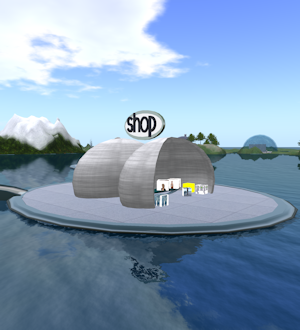 over to another “grid” or virtual world called Reaction Grid. I knew the members of this group were more focused on the use of virtual worlds for business and engineering so I visited. Now I am hopeful that I have finally found the grid I had been searching for to help me focus on the engineering and business aspects of virtual worlds.
over to another “grid” or virtual world called Reaction Grid. I knew the members of this group were more focused on the use of virtual worlds for business and engineering so I visited. Now I am hopeful that I have finally found the grid I had been searching for to help me focus on the engineering and business aspects of virtual worlds.
Not only are most of the residents of this grid very intent on using virtual worlds to enhance business, but the people running the grid are interested and involved in the projects that their residents are developing and working on. They are also involved in helping all of us better understand the technology behind virtual worlds.
I think this involvement in community, which is somewhat opposite of the hands-off approach of the Second Life grid, is important for several reasons. First, if we are to leverage this technology for our work, we need to have a good understanding of how it works and its capabilities. I like that the people running the grid have invested in hosting events and classes to help us in this endeavor because I think the faster everyone learns the technology, the faster the grid will develop.
Second, what this does is encourage more residents to also get involved in helping to move development forward, not only with their own projects, but with the grid as a whole. I think the ThinkBalm Innovation Community site 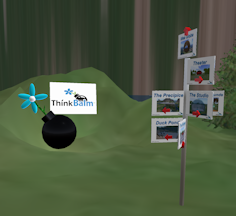 on Reaction Grid is indicative of this commitment to community. This group, which is dedicated to advancement of the Immersive Internet, is based on the collaboration and sharing of ideas.
on Reaction Grid is indicative of this commitment to community. This group, which is dedicated to advancement of the Immersive Internet, is based on the collaboration and sharing of ideas.
Next, some of us who are interested in using virtual worlds do not have all the skills necessary to completely develop our own projects. Working within a grid that promotes involvement makes it much easier to find others who might be willing to help.
I recently had an experience that illustrates this: In an effort to show others in my field the benefits of virtual worlds, I have been trying to set up a simple 3-D SCADA. I know it can be done, I am convinced that this is where our operating technology will soon be for our water and wastewater plants, and I know it is something to which everyone in my field could immediately relate. But trying to find a programmer in Second Life who understood what I was talking about and who was willing to do this was impossible.
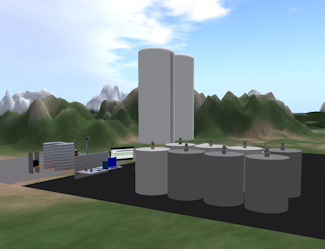 However, over on Reaction Grid, there were several who immediately knew what I was trying to accomplish. The owner even built a demonstration project on the grid showing how a fuel facility could monitor fuel levels and then notify operations when the tanks needed to be refilled. Now I finally feel there might be a chance I will one day help introduce virtual worlds to engineers and operators using a 3-D SCADA demonstration.
However, over on Reaction Grid, there were several who immediately knew what I was trying to accomplish. The owner even built a demonstration project on the grid showing how a fuel facility could monitor fuel levels and then notify operations when the tanks needed to be refilled. Now I finally feel there might be a chance I will one day help introduce virtual worlds to engineers and operators using a 3-D SCADA demonstration.
One other attraction for me has been the approach that Reaction Grid has taken to building a grid. Instead of buying land and paying tier (tax) as we do in Second Life, on Reaction Grid, you can pay to host a sim which reminds me much more of how Websites are hosted and set up. That seems like a much more viable and long-term business solution for the creation and hosting of virtual worlds. Particularly now that the hypergrid technology has been implemented. Second Life is now a walled garden that you cannot leave while these other grids allow you to move from grid to grid just like we do between Websites.
Aside from all this business, I do have to admit, there is also an element of fun to virtual worlds that increases their appeal. And attending interesting virtual events does help to further connections and community. I think Second Life has a lot to offer along these lines, and even though Reaction Grid is more focused on business, they also incorporate 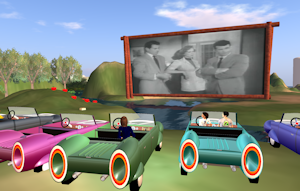 interesting builds and fun events. One of the most entertaining events on the grid has been Fright Night – an event that is set up like a drive-in movie theater where we watch great, old, creepy shows and throw tomatoes at the screen. I know that is where I will try to be every Saturday night. And whether you are interested in developing an engineering project or throwing tomatoes at a movie screen, Reaction Grid seems to be the place to be.
interesting builds and fun events. One of the most entertaining events on the grid has been Fright Night – an event that is set up like a drive-in movie theater where we watch great, old, creepy shows and throw tomatoes at the screen. I know that is where I will try to be every Saturday night. And whether you are interested in developing an engineering project or throwing tomatoes at a movie screen, Reaction Grid seems to be the place to be.
Your Social Media Journey Begins Here
So how many times have you tried to convince your friends and colleagues that they should be on Twitter or LinkedIn? Are you the person making the rounds in your office showing everyone Second Life and trying to convince them of the benefits of virtual worlds. I know I am one of those people shouting the benefits of Web 2.0 from the rooftops. And I share in everyone’s frustration because even though people seem to understand and “get it,” they never make that final step to actually join.
One day, I showed a vendor some social media tools, and he seemed very interested in using them. But I sensed some hesitation, so I asked, “If everyone understands these tools and is interested in using them, why don’t they?” And his response was, “I just don’t know how.”
That simple response said a lot. So I changed my plan of attack from demonstrating the tools to establishing a road map of how to get started. The result of that was this document: Your Social Media Journey Begins Here. I am releasing it in Beta form since I am sure there are still some mistakes in it, and I am sure it could use some tweaking. So if you want, take it, give it to your friends, test it out. Let me know how it goes. I probably should mention that it is targeted at people working in government, engineering, and public works.
(For those of you who would rather read the document in digital book form, click here.)
Who’s Leading the Charge to Web 2.0?
Today I read a recently released white paper, Government 2.0: Building Communities with Web 2.0 and Social Networking. Overall, I thought the paper did a good job summarizing much of the ongoing, online discussions and research on this topic. However, I sensed an underlying attitude that concerned me as a government employee. This unspoken, read-between-the-lines belief by the author was finally put to words in the conclusion when he stated: “Ultimately CIOs must decide for themselves if Web 2.0 technology makes sense for their community and if this is the time to invest in it.”
Now, I don’t know about the rest of you working in government, but I can’t begin to tell you how many times our city attorney has lectured me that we are only employed to give advice; it it the job of the elected officials to make the final decisions. I realize we are left to make some decisions on a daily basis without having to run to the mayor or city manager each time, so I take his comment as meaning the “big” decisions. As the city engineer, I can make recommendations about what roads need to be repaired, but in the end, the mayor and the aldermen make the final choice. And I make the repairs based on their decision.
So making the statement that ultimately it will be up to the CIO to decide if his community should embrace Web 2.0 is like saying it is up to our city attorney to decide if he should begin legal proceedings to condemn and demolish someone’s home that doesn’t meet local ordinances. All of us would think that is ridiculous. Those types of community-wide decisions that have the chance to impact our citizens and expend funds must be made by the elected officials. CIOs can recommend and present implementation of Web 2.0, but ultimately, the elected officials will be the ones to accept or deny its use.
The role of the CIO is something I have been thinking about for some time and even more so since meeting Bill Greeves, Director of Information Technology for Roanoke County, Virginia. He and I co-founded the MuniGov 2.0 group to serve as a resource for local government folks looking at Web 2.0 implementation. Not one of the members of this group, who are primarily people working in the information technology or computer fields, have ever expressed an attitude or opinion similar to that put forth by this report. In fact, all have viewed their role in this as a professional who has recognized the need to develop the skills necessary to face the future Web 2.0-related demands of their agency. They all have approached implementation of Web 2.0 as that of a person who will most likely lead the charge, but primarily as a facilitator, collaborator, and mentor to others in their workforce.
Their approach has restored an image I had of that profession that was obviously undeserving but brought about by years of hearing others in government complain about the IT department. The complaints I have heard are that IT prevents them from being able to do their work by restricting access to programs. Talking with Bill about this, I realize that IT has an important responsibility to protect the security of the network, and most likely, these restrictions have been set in place by IT to accomplish that task. But Bill takes a very practical approach to this by indicating that while security is vital, that goal should not keep an IT professional from working with others in the agency to investigate implementing needed software. (See his article on this – published by the same entity that published the report above – addressing this topic from an IT professional’s perspective: Can’t We All Just Get Along?)
As we move into the future and acceptance of Web 2.0, I do believe that IT professionals will be moved out of the basement (as so humorously depicted in the British television show, the IT Crowd) and take a well-deserved place on the upper floors. And I believe that instead of complaining about how IT keeps everyone from being able to do what they want to do, people need to realize how much IT does to make sure they can keep working. We need to “friend an IT person,” find out what their job really entails, and realize that as computers increase in importance, it will be these folks who most likely will be leading the charge. But the charge will not be successful if they do not obtain the trust and buy-in from other departments (and comments like those in this report do not facilitate that type of cooperation with people who already look upon the IT department with distrust and consternation). And no one will be charging at all without the green light from elected officials.
Civil Engineering in the Virtual World
For the past two years, I have been exploring Second Life as a potential tool for civil engineers, public works professionals, and local government. Now, thanks to Silverwing Benoir, a friend of mine from Second Life, I will have the opportunity to present what I have discovered, try to offer some insight into future applications, and hopefully generate some interesting discussion. If anyone is interested in attending this talk, titled Simulating Civil Engineering Projects in Virtual Worlds, it will be held in Second Life at noon (EST), Monday, Dec. 29, 2008. You can register for the presentation for free at the Value-Train Website.
